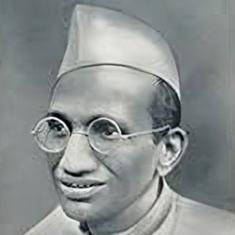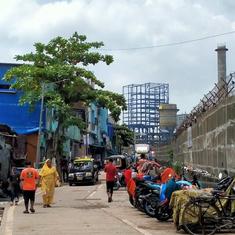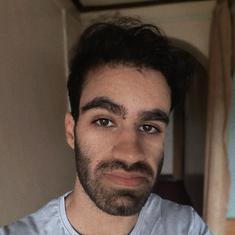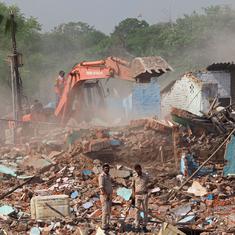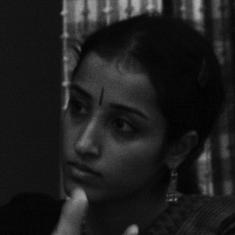In the last six months, Amala M’s family of nine has suffered untold tragedy. First, one of her brothers died of a heart attack. Then, another died of an illness. But while these left her grief-stricken, the fate of the third, Vasanthakumar, has also plunged her into guilt.
“It was a mistake,” Amala said with tears streaming down her eyes. “I should never have sent him there. I should have just let him stay here, with us.”
Thirty-six-year-old Vasanthakumar, who worked as a carpenter, began to drink excessively after the death of his brothers, Amala recounted. “He would look at their pictures on his phone and become depressed,” she said when I met her in September. “He didn’t go out and drink. He would sit quietly and drink by himself, right here.” She pointed to a bed where her two ill daughters lay sleeping on a school day.
Amala’s family lives in a small two-room flat in a colony built by the Tamil Nadu Urban Habitat Development Board in Pulianthope, Chennai. The colony looks neglected – its lanes are filled with litter, drains run full and plaster crumbles from the buildings, whose walls are covered in cracks and patches of damp. Its residents are also neglected, said Suresh Kumar, Amala’s younger brother. “Many people living here suffer from alcoholism,” she said.

Amala recounted that Vasanthakumar never got into fights or caused any trouble. “That was not the issue,” she said. “But he wasn’t eating properly. He would just drink and not eat and I could see that it was affecting his health.”
Sometime in May, Amala ran into a neighbour she knew who had recently returned from a stint at a de-addiction centre. She noticed that he looked significantly healthier than he had before. “He used to be a very skinny man but he had put on weight,” she said. So she asked about the centre and decided it might be good for her brother to get some professional help. So she reached out to the centre, known as Phoenix Social Service Trust, in the locality of Vanagaram, around 15 km away.
Suresh Kumar handed me the centre’s business card. It described the centre as a “halfway home for chemical dependents” and a psychiatric hospital. The fee for one month at the centre was Rs 10,500, Amala said. She borrowed some money and combined it with her savings to pay for her brother’s treatment.
On May 9, personnel from the centre picked up Vasanthakumar from his house and admitted him to the de-addiction centre. Amala said she was in regular contact with one of the staff members at the home. “They forbid us from visiting him but we could call every alternate day to enquire about him,” Amala said. She was not allowed to speak to her brother directly but could speak to a particular staff member. So, unfailingly, Amala rang up the staff member every alternate day. Every time she called, the staff member sounded optimistic about her brother’s progress.
“They would tell me he was eating and sleeping well,” she said. “The staff would speak to me very sweetly and say that he would look after my brother like his own.”
On May 26, too, Amala made her regular call. “I was told that he had eaten oats and had gone to bed,” she said.
The next day, around noon, Amala received a call from somebody at the home saying that her brother had been taken to Government Kilpauk Medical College in Chennai because he had experienced shortness of breath.
Amala and her relatives rushed to the hospital. They recognised some employees of the home at the hospital but nobody spoke to them. “Then we saw a stretcher with my brother lying on it, lifeless,” she said. “We all started screaming and shouting. We were in shock.”
Vasanthakumar’s body was cold. “We knew immediately that he had been dead for hours,” Amala said. “Nobody was treating him. He was just lying abandoned.”
The family noticed injuries and blood clots on his chest and face. Amala’s aunt flew into a rage and ran to the employees of the home who were present at the hospital, demanding to know what had happened. “I caught them by the collar,” she said. But the employees did not give them any answers.
“Then a doctor took me to the side and said that my brother had been brought dead to the hospital and that they had not given him any treatment, and so cannot be blamed in any way for his death,” Amala said. “He told me that if I have any grievances, I should take it up with the home where I had admitted him.”

The family decided immediately to file a police complaint against the centre over Vasanthakumar’s death. Soon after, an employee from the home “contacted us on the phone and said that my brother had been suffering from jaundice”, Suresh Kumar said. “Then they changed their story and claimed that he had been drinking inside the home. They would not give us a straight answer. But they urged us not to file a complaint.”
Scroll emailed the administration of the centre to seek their responses to these allegations pertaining to Vasanthakumar’s death. This story will be updated if they respond.
If the centre was not hiding anything, “they would have reached out to us and told us what had happened,” Amala said. “If they had failed to help him, they should have just sent him back.”
This story is part of Common Ground, our in-depth and investigative reporting project. Sign up here to get these stories in your inbox as soon as they are published.
Tamil Nadu has among the highest rates of alcohol use and dependence in the country, according to a survey commissioned by the Ministry of Social Justice and Empowerment.
The ministry’s website carries a set of guidelines for government rehabilitation centres established under the Central Sector Scheme for Prevention of Alcoholism and Substance Abuse. According to these guidelines, depending on its size, a centre must employ a specific number of individuals to fulfil different duties. For instance, a 50-bed centre is required to have a project coordinator who also serves as a vocation counsellor, an accountant, a cook, two security guards, one part-time doctor and one full-time doctor, six counsellors, four nurses, two ward boys, a peer educator, and either a yoga therapist or a dance, art or music teacher.
The state has around 300 de-addiction centres under the Tamil Nadu State Mental Health authority, which also serve as rehabilitation centres. Additionally, the National Health Mission Tamil Nadu’s website states that it has established de-addiction centres in 10 districts, each of which cater to around 5,000 in-patients of de-addiction and up to 50,000 outpatients every year.
But some parents choose to send family members to private centres.
“The government centre is free and so I feared my brother may not get good treatment,” she said. “I felt if I paid money to a private place for his treatment, they would look after him well. I was wrong.”
Amala was not aware that de-addiction centres, particularly private ones, have for some years been under scrutiny for their treatment of inmates.
A 2021 study on the legal, ethical and professional concerns surrounding addiction treatment in India noted, “Our findings suggest that the addiction treatment system in India is still riddled with the old punitive ‘teach addicts a lesson’ approach. Hence, individuals with substance use disorders and other addictions still face degrading treatment in some treatment facilities in the country.”
Further, it observed, “Instead of being a place for healing, our study indicates that many of the treatment facilities, especially those privately owned, have become places of torture.” This problem was exacerbated by inattention “from the concerned government bodies, lack of regulation in the addiction profession, and to an extent, lack of awareness of the service users”, it added.
The researchers analysed three newspapers in India to track down the number of instances in which inmates had been beaten to death in de-addiction centres. They found that 13 such deaths had been reported between 2013 and 2016. The researchers noted that there was a high possibility that these deaths were severely underreported.
The problem of such centres has also come to the attention of government bodies. In April 2023, the National Human Rights Commission took suo motu cognisance of a media report of the death of a 24-year-old man who was beaten to death by staff at a de-addiction centre in Dehradun, Uttarakhand. The commission stated that it had also taken suo motu cognisance of two similar incidents in Noida and Ghaziabad, Uttar Pradesh.
The commission expressed concerns about private entities being allowed to run de-addiction centres. “It needs serious consideration as to whether the de-addiction centres can be allowed to be operated by private entities, and if it is so, whether state(s) have ensured sufficient safety measures in place to protect the interest of the inmates with a view to achieving the desired goal,” the commission stated.

Tamil Nadu has seen several such incidents. In fact, one made the news in July, the month after 66 people died of alcohol poisoning in the district of Kallakurichi. The incident involved a 38-year-old man who died, allegedly after being assaulted by members of a de-addiction centre in the same district. In this case too, the staff at the centre claimed that the victim had suddenly been taken ill and rushed to the hospital, but, as in Vasanthakumar’s case, doctors said that he had been brought dead. After a case was filed, the deaddiction centre was shut down and the inmates were transferred to a government de-addiction centre.
A case from November 2023 also bore resemblances to Vasanthakumar’s. It involved 28-year-old P Vijay, an auto-rickshaw driver, who died after being allegedly assaulted at a de-addiction centre in Chennai. The staff at the Green Life Foundation centre, where he had been admitted claimed that Vijay developed chest pains and shortness of breath. He, too, was taken to Government Kilpauk Medical College.
“When we got there we realised that he was dead,” said Rajesh, Vijay’s brother. “The staff at the centre said that they would take care of the funeral expenses.” Rajesh said that he found this odd and insisted on seeing his brother’s body.
That is when he noticed that there were several bruises on the body. “He had only been admitted for a month,” he said. “How can somebody just die suddenly?”
Vijay’s mother had admitted him to the de-addiction centre after several complaints about his alcohol abuse from his in-laws. “She had not informed the rest of the family that she had admitted him. We only got to know about it after he died,” Rajesh said.
He added, “His condition wasn’t so bad, we should have just let him be. I wish he had never gone there.”
Rajesh doesn’t believe that the police are going to investigate the case fairly. “We asked for a postmortem but the police said it would take a month and never got back to us,” he said. When the case was filed, three employees were arrested. However, Rajesh said, the deaddiction centre did not close down.
“We are a very poor family and don’t have the money to pursue the case, so we have given up,” he said.
His hopes of securing justice for his brother rose briefly after a local media channel broadcast an interview on YouTube with the family. Rajesh said that some people commented on the video recalling their own experience in the same deaddiction centre. “Some people said that they had also been beaten brutally at the centre,” he said. But his hopes faded just as quickly. “When I tried to get in touch with those who commented on the video and discuss the issue, they simply didn’t respond,” he said.
The website of the Ministry of Social Justice and Empowerment carries a manual on the “minimum standard of care” that deaddiction centres, both those run by the government and non-governmental bodies, must follow. The manual states that inmates, whom the manual also refers to as clients, and their families have several rights, including “the right to a supportive drug-free environment, to dignity, respect and safety, to be fully informed of the nature and content of the treatment as well as the risks and benefits to be expected of treatment, to be made aware of conditions and restrictions prescribed in the centre before admission”. The manual also directs centres to allow inmates to have visits from family or support persons while in treatment.
At most private centres, however, little attention is paid to rules and regulations. In April 2023, the Madras High Court directed government authorities to conduct periodical inspection of privately-run deaddiction centres. It made this observation while dismissing a petition by M Syed Ali Fathima, who sought 10 lakh compensation for the death of her husband at one such centre – the court directed a sessions court to complete the trial within four months.
From what former inmates at the centre described, none of these minimum standards of care existed in the Phoenix de-addiction home. “How can a doctor not be present at the centre?” Amala asked.
Amala is still angry that her neighbours, several of whom had been admitted to the same centre, did not warn her about the treatment meted out to inmates.
One of these neighbours, K Karthi, an autorickshaw driver, who spent a few months at the same centre about two years ago, and who was present at Amala’s house, spoke of his experience. He recounted that the workers “beat inmates who caused trouble”. He explained that this could include “shouting, throwing tantrums, back-answering”.
But, he noted, “they would only beat the inmates in the night when everyone was asleep. Nobody outside could hear what was happening inside”.
He said that he himself was spared “because my family paid them extra money and warned them not to beat me. They beat those who did not pay as much as me.”
When he said this, Amala said, grudgingly, “He could have told me this before.”
Repeatedly, during our conversation, she said, “If I had even the slightest idea that the people at the centre are violent, I would have never sent my brother there.”

As we spoke, V Appu, a 31-year-old neighbour, also arrived at Amala’s house to talk about his experience at the home. “It was hell, pure hell,” he said. “I know people get beaten up in jail but I can give it to you in writing that this de-addiction centre is worse than any jail. Honestly, I would have preferred jail.”
Four months ago, Appu’s family asked the staff at the Phoenix Trust to pick him up for treatment. “They asked my family to ensure I am alone at home when they come to pick me up. My family was supposed to sign an agreement stating that I will remain there for three months,” he recalled. “They put me in the vehicle and then drove to the centre. The first three days I was in a daze, I had no idea what was happening.”
The centre housed between 30 and 40 people, Appu recalled. They were all made to sleep on bunk beds.
Soon after he arrived, he discovered to his shock that the toilet did not have any walls. “It was an open toilet,” he said. “There were no doors. Just imagine what that would be like. I was hesitant to use the toilet because it was so embarrassing.”
Karthi confirmed this. “All 30 of us had to use the same toilet,” he said.
When they first entered the centre, Appu said, the staff handed over to the new inmates a small soap and two beedis. “You know the soaps that cost 10 rupees? That will hardly last you a week,” he said. “But if you ran out they would not give you another soap. You had to make do with water.”
They faced the same problem with the soap they were given to wash their clothes. “After we ran out, they would take a piece of soap and dunk it in the water and rub it, so the water got a little soapy,” he said. “That is what we would use to wash out clothes.”
He recounted that the food was inedible. “The sambar was just water,” he said. “It was the same food every day. My stomach was a mess.”
From the beginning of the day until the end, Appu said, the staff would find opportunities to beat the inmates for the smallest of mistakes. “If they dropped rice while eating. If they requested anything or if they made noise. Just about anything would result in the person getting beaten with a big stick,” he explained. Within a day or two, Appu learnt that the only way he would survive at the centre would be if he remained very quiet and kept entirely to himself.
“Even if we looked in the direction of the entry gate, they would beat us,” he said. “If anyone complained about anything they would get hit.”
Amala added, “All the staff look like bouncers.”
Appu concurred. “They are not medical professionals, they just looked like bouncers who are there to scare you and beat you,” he said. “I wasn’t able to go to the toilet for a week because I was petrified of them.”
He recounted that the torture would be extreme in nature. “I saw them hang one person by his legs and hands and beat him from behind endlessly,” he said. “I don’t understand why they beat us even when we were sober and alert.”
Inmates’ families were only allowed to visit once a month – on the day that they had to pay the month’s fees. “Even then we are not allowed to meet them in person. They would bring us clothes but the staff would never give it to us,” Appu said. “They stood far away and looked at us through a gate. And we could see them through a small television set that they kept in the room.”
Appu returned 18 days after he was admitted because his family decided that he was better off at home. “I was angry that they sent me away but I was so relieved when they came back to get me,” he said. “But I’m still very angry with them. Because I have nightmares about being back in that place. It haunts me. It severely affected my mental health, and I still suffer.”
I asked Appu if a psychiatrist or counsellor ever met him and if he was given any counselling at the centre. He seemed uncertain about what that would entail – when I explained, he let out a small laugh. “Nobody talked to us,” he said. “Nobody gave us any advice or anything. I’m telling you, jail would have been better.” He added, “We were not even allowed to talk to each other. We would get beaten if we spoke to anybody else.”
The only interaction that inmates had with any medical professional was with a doctor who visited once a week to check their vitals, Appu recounted.
Sometimes, the staff would make them do yoga, Karthi said. “But we could not take a walk or look outside or even walk in the corridor,” Appu added.
Appu and Karthi said that the de-addiction centre would refuse to release inmates if they weren’t able to pay the fees or if they wanted to leave for other reasons. In this regard too, it was starkly different from the government’s recommendations in the manual, which state that inmates should have “permission to get discharged from the programme due to personal reasons at any time without physical or psychological harassment”.
After filing the police complaint, Vasanthakumar’s family eagerly awaited his postmortem. “But the police were least interested in ensuring the report is released soon,” Suresh said. “I kept calling them to ask about the status of the report and they kept making excuses and delaying the process.” Kumar finally went to the hospital to enquire about the matter. “They said it was ready but that they would only hand it over to the police,” he said. “So I rang them up and asked them to go and pick it up.”

The postmortem identified the cause of death as a heart attack, the family said.
But the postmortem also made other observations – such as that there were healed abrasions with blackish scabs on different parts of Vasanthakumar’s arms, the central part of his body, his back, his knee, his leg and his ankle, and dark red abrasions on his wrist and multiple incisions all over his body. “It makes no sense,” his cousin said. The post mortem also found that there was no trace of alcohol in Vasanthakumar’s body.
“Look at this photo,” Suresh said, handing me his phone with a picture of Vasanthakumar on it. “Look at how healthy he is. When we saw him on that stretcher he was all skin and bones, like he had not eaten properly in days. And his teeth looked like they had not been brushed in days.”
Amala struggled to understand how he could die so suddenly. “If, like they say, he had jaundice, why were we not informed?” she said. “And why did they bring him to a hospital 10 km away if it was an emergency. If he had been ill, we would have brought him home and taken care of him.”
Kumar insisted that the staff at the centre were lying. “There is no way that he was sick.” he said. “We want to know what happened inside. There is CCTV footage available. The police must secure it and see what the tapes show.”
In the months since his death, nobody from the centre has tried to reach out to the family. They have also not heard from the police after officials gave them the post mortem.
At Amala’s house, those who were gathered weighed in with fond memories of Vasanthakumar. “He was the most handsome person in our family,” Vasanthakumar’s aunt said, weeping. “And the kindest boy.”
Hari, a neighbour and childhood friend, recounted that he regularly fed street dogs. “Every time he stepped outside, he would be surrounded by dogs,” he said.
Vasanthakumar’s family has one primary demand – that the government withdraw the de-addiction centre’s license and shut it down permanently. “What happened to my brother should not happen to anyone else,” Amala said. “The government must find out what happened to my brother and take action against the accused.”

